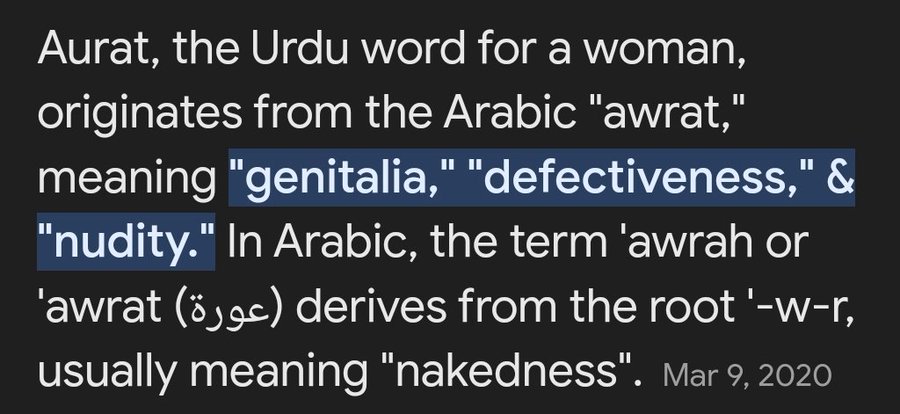We use the word Aurat every day without questioning its origin. But many words adopted in Hindi via Urdu carry centuries of pain, disrespect, and hidden meanings. Unfortunately, the commonly used term for adult female humans, Aurat, is one of them.

Aurat stands derived from the Arabic word “Awrat.” And Awrat doesn’t mean woman. It indicates “nakedness,” “defect,” or “shame” and even “genitalia” at times. Thus, why then do Hindi speakers still use Aurat to describe half its population? It’s time we ask tough questions and demand change – starting with our children’s textbooks.
The Meaning of Awrat: A Hidden Insult

The Arabic word ‘Awrat’ refers to something that must be hidden or covered. In classical Arabic and Islamic theology, it specifically refers to genitals or private parts. Specifically, it denotes parts of the body considered shameful or “defective” if exposed. In fact, in Islamic jurisprudence, a woman’s entire body is ‘awrah.’ Thus, making her entire physical presence something to be concealed.
The root word of Awrat implies “deficiency,” “imperfection,” or “flaw.”

In Persian and later Urdu usage, Awrat morphed into Aurat! And this became the generalized term for women in the Indian subcontinent. However, the inherent negativity of the word never disappeared. Thus, Muslims prefer to use alternative words for their women folk. The Persian and Kurdish language consider Aurat the term for women, but seldom use it. Unfortunately, Aurat traveled silently across cultures, embedded itself in Bharat’s daily language, books, and education.
From Awrat to Aurat: A Linguistic Colonization
As Islamic invaders crossed the Hindu Kush mountains, their language came too. Hence, along with the dust of Islamic conquests, Bharat faced the onslaught of forced cultural invasion. Arabic and Persian languages fought to become the language of the Indian Subcontinent. However, they merged with Hindi to give birth to Urdu, the language that resembles Hindi but carries with it the genes of Arabian Islam.
The years of forced slavery and linguistic oppression ensured the corruption of Hindi language with Urdu words.
And this corrupted Hindi embraced the term Aurat as a gendered term to denote women. But the roots of the term didn’t change. Neither did the context of why this word was used for Indian women. And in the eyes of the invaders the women of Bharat had accepted their fate at the hands of the invaders.
Hence, for the Islamic fanatic invaders, women of Bharat readily called themselves “Aurat” – this hateful term denoting themselves as property, spoils of war, or objects of lust.

It’s not far-fetched to think that the word was used deliberately to dehumanize. To label women with a term that originally meant “shameful or defective” was no accident. This wasn’t just linguistic borrowing – it was linguistic conquest. It was a subtle but potent way of undermining cultural respect for women in Bharat. In the Islamic invaders’ eyes, Hindu women of Bharat were “Awrat” — hidden, owned, defective, and dishonored.
Why Aurat Doesn’t Belong in Bharat’s Schools?

Today, children across India learn to call women “Aurat” along with the men “Adami.” Both the terms are out of the Islamic playbook. The preschool curriculum does not ever question the word’s bloody or degrading past.
Pre-school books happily implant the word Aurat for women in the minds of a gullible child.
Nursery rhymes and language primers use it as a neutral term. However, the term is not neutral. And the practice is dangerous. Why are we teaching our kids to associate womanhood with shame and defectiveness? How will it affect their worldview when they grow up to understand its etymology?
By continuing to use “Aurat” for women, Bharat is unconsciously planting a mindset of inferiority and shame in the next generation.
The need of the hour is to recognize the genesis and the meaning of the word. This isn’t a vocabulary war – it’s a war on values. If Bhart wants to raise a generation that truly respects women, we must begin with respectful language. Hence, schools and care-givers need to stop teaching the word Aurat!
Use ‘Nari’ or ‘Stree’: Words That Celebrate, Not Shame
Indian languages have beautiful, dignified, and empowering words for women. The word “Nari” embodies Shakti and Stree in Sanskrit defines the feminine. These words reflect power, grace, creation, and strength.
Unlike “Aurat,” they don’t carry the baggage of foreign patriarchy or a heritage of shame.
Even phonetics matters. The Urdu/Arabic “Aw” in “Aurat” comes from “Awrat,” the word for defect or nudity. It is not the correct representation of the Hindi swar औ. In Sanskrit, the swar“ औ” is found in words like “Aushadhi” which means medicine. Should we not teach our children to associate the sound “ औ” with healing, not humiliation?
In Conclusion: Rewrite, Reclaim, and Respect

Language is not just a tool of communication. It is the conduit of power, identity, and memory. The word “Aurat” is an Islamic term with a legacy of gendered oppression. It is time to purge it from Bharat’s Hindi vocabularies, especially in the ones we teach our future generations.
Let Bharat reclaim its linguistic sovereignty.

Let’s replace “Aurat” with words that uplift – “Nari,” “Stree,” or simply “Mahila.” Let every girl know from her first textbook that she is not a defect. She is a force of nature – Shakti or Feminine Divine. It’s time to stop calling women with a term that denotes ‘nakedness’. Let’s call them strength. Call them sacred. Let’s free Hindi from this word deeply rooted in insulting or reducing women to their genitalia!


